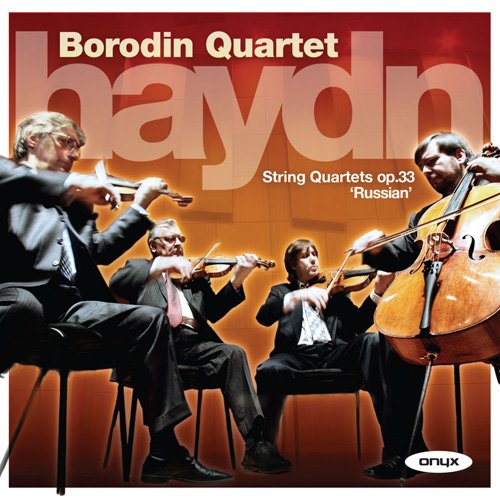Borodin Quartet - Haydn: String Quartets Op.33 "Russian" (2011)

Artist: Borodin Quartet
Title: Haydn: String Quartets Op.33 "Russian"
Year Of Release: 2011
Label: Onyx Classics
Genre: Classical
Quality: FLAC (image + .cue, log, booklet)
Total Time: 01:44:22
Total Size: 546 MB
WebSite: Album Preview
Tracklist:Title: Haydn: String Quartets Op.33 "Russian"
Year Of Release: 2011
Label: Onyx Classics
Genre: Classical
Quality: FLAC (image + .cue, log, booklet)
Total Time: 01:44:22
Total Size: 546 MB
WebSite: Album Preview
Franz Joseph Haydn (1732-1809)
String Quartet in B Minor, Op. 33, No. 1
I. Allegro moderato
II. Scherzo. Allegro di molto
III. Andante
IV. Finale. Presto
String Quartet in E Flat, Op. 33, No. 2, "The Joke"
I. Allegro moderato
II. Scherzo. Allegro
III. Largo
IV. Presto
String Quartet in C, Op. 33, No. 3, "The Bird"
I. Allegro moderato
II. Scherzo. Allegretto
III. Adagio ma non troppo
IV. Finale. Rondo - Presto
String Quartet in B Flat, Op. 33, No. 4
I. Allegro moderato
II. Scherzo. Allegretto
III. Largo
IV. Finale. Presto
String Quartet in G, Op. 33, No. 5, "How Do You Do?"
I. Vivace assai
II. Largo e cantabile
III. Scherzo. Allegro
IV. Finale. Allegretto
String Quartet in D, Op. 33, No. 6
I. Vivace assai
II. Andante
III. Scherzo. Allegro
IV. Finale. Allegretto
Often referred to as the "Father of the String Quartet" (no to mention the symphony), it was with his set of Six String Quartets, Op. 33, that Haydn truly began to make his unique and singular mark on the genre. The set is frequently termed collectively as the "Russian" quartets owning to their dedication to a Russian nobleman, they were also the quartets that inspired Mozart to write his so-called "Haydn Quartets." By Op. 33, Haydn had the independence of the four parts making for much more melodic and textural freedom within his scores. The set is especially sunny in disposition; even the first of the set -- the only one in a minor key -- is far from brooding or pessimism. The Borodin Quartet, featured on this Onyx two-disc set, does a splendid job of highlighting the lighthearted, jovial nature of these six masterpieces. Though the violin features prominently in Haydn's score, the Borodin's do not produce a sound that unduly favors the first violin. Rather, all four parts are equally robust and vigorous, ideally matching Haydn's progression toward an intimate conversation among equals. The interpretations are aggressive and driven, though not romanticized or rushed. Energy, spontaneity, and joy of music-making result in a set that's equally joyous to listen to. -- Mike D. Brownell




![Kaidi Tatham - Miles Away (2025) [Hi-Res] Kaidi Tatham - Miles Away (2025) [Hi-Res]](https://www.dibpic.com/uploads/posts/2026-01/1767536832_a2560084361_10.jpg)

![Organic Pulse Ensemble - Bamboo Noodles (2025) [Hi-Res] Organic Pulse Ensemble - Bamboo Noodles (2025) [Hi-Res]](https://www.dibpic.com/uploads/posts/2026-01/1767515726_l8l51uoc94s2b_600.jpg)
![Erika Dohi - Myth of Tomorrow (2025) [Hi-Res] Erika Dohi - Myth of Tomorrow (2025) [Hi-Res]](https://img.israbox.com/img/2026-01/03/2w8wezeg5u9w6h7u5ihkozt5b.jpg)
